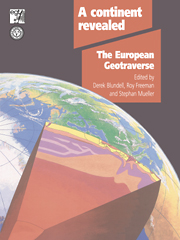7 - GEODYNAMICS OF EUROPE
Published online by Cambridge University Press: 05 November 2009
Summary
HOW DOES GEOLOGY WORK?
In this book we have endeavoured to present a coherent view of the lithosphere of Europe, brought into focus through the European Geotraverse which provides continuity across the continent on a scale that encompasses the whole lithosphere. We have made use of this to reconstruct the geological evolution of the crustal units that now make up the continent of Europe, within a framework of plate tectonic processes taking place throughout the past 2 Ga of Earth history. But what of the mechanisms? What forces drive these processes? And how do some areas of the continent remain stable over long periods of time whilst others are remobilised again and again? What are the processes that split continents, fragment them into microplates, and what are the processes of terrane accretion and continental growth? Within a continent, deformation and alteration take place across extensive regions so that plate boundaries are not definable as lines of activity separating rigid undeformable plates as is the case in the oceanic regime. This is understandable from the discussion in Chapter 4 because the composition and physical conditions of continental crust are such that the rheology creates a weak zone in the middle crust that gives continental lithosphere a ‘soft centre'. In contrast, the thin crust and basaltic composition of the oceanic lithosphere provide a more uniform and stronger rheological character. But if the continental lithosphere does have a ‘soft centre' and is more readily deformable, why does it not deform more extensively than it does? Why, for example, is the Alpine collision zone so narrow?
- Type
- Chapter
- Information
- A Continent RevealedThe European Geotraverse, Structure and Dynamic Evolution, pp. 215 - 232Publisher: Cambridge University PressPrint publication year: 1992
- 6
- Cited by

